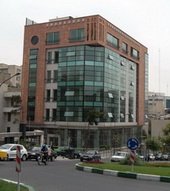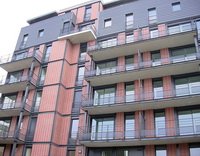Brick facade, the oldest of facade materials in use by contemporary Architects

Brick facade is used totally or in combination with other cladding materials such as glass, stone or aluminium to add some zest to the building curtain wall.
But the following issues should also be considered at the design and planning stages.

Many problems that occur in a brick facade stem from the expansion of the brick due to moisture and direct sunlight, effects of freezing and thawing, and problems arising from insufficient firing of the brick.
Brick cladding attached to concrete frame buildings is subjected to serious stress build up because the concrete will tend to creep with time while masonry has a tendency to swell.
To alleviate cladding problems it is necessary to provide enough shelf angles for support and sufficient horizontal expansion joints in the wall to allow the two components, concrete and brick, to move independently. Check Masonry Advisory Council for further technical and spec info.
Most modern commercial walls are constructed as either barrier or cavity systems. Barrier wall systems are designed to keep water out of the wall and to rely on the exterior surface and joint seals to prevent (or mitigate) water infiltration into the building.
Alternatively, cavity walls have a drainage plane and waterproofing barrier behind the exterior cladding and a means to divert water out of the wall.
This, ensure that the water is not trapped behind the facade of the buildings in areas where winters are harsh. Otherwise the water freezes and expands, dislodging the brick. Water that is past the cladding runs down the drainage plane and out of the wall through the weep holes at the base or at flashing joints.

A similar problem occurs if brick is supported on untreated steel structure. When steel rusts it flakes and expands, pushing out the brick. Proper coating of steel to prevent rust is therefore necessary. The cladding joints should be detailed in such a way as not to jostle each other under building movements.
Some of the benefits of using bricks as a facade material are:
- It is relatively easy to install, since there is only one layer of masonry to deal with.
- It is generally more affordable.
- It requires a relatively simple foundation and support system.
- Like solid brick, veneer is durable and fireproof, it looks fancy and it requires little maintenance and no paint or stain.

Return from brick facade to curtain wall system
Return from brick facade to curtain wall cladding


